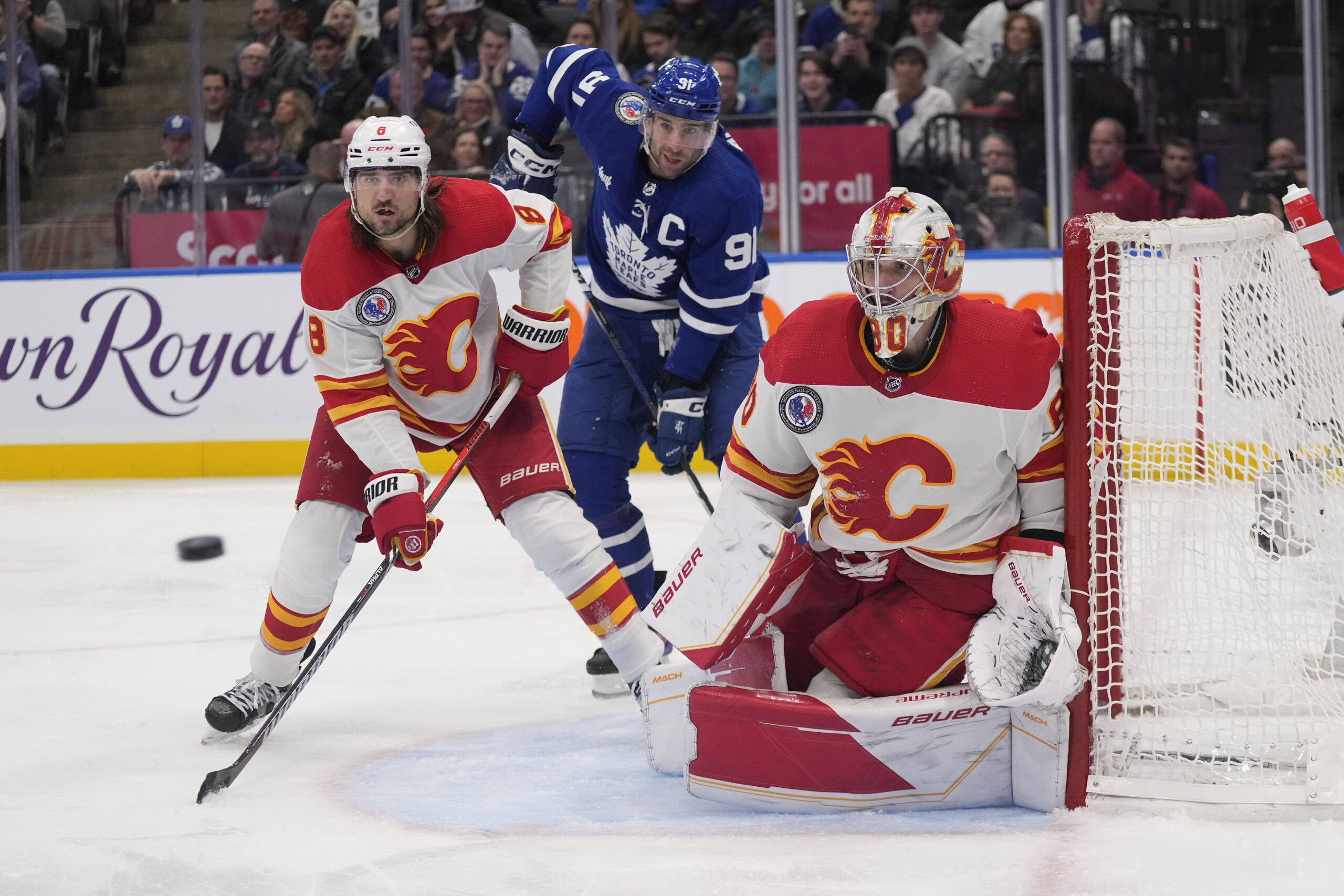The story of the 2024 draft for the Maple Leafs is just as much about the 2023 draft before it and the 2025 draft that follows it.
In 2023, the Leafs drafted three times: in rounds one, five, and six. The Leafs entered this weekend with just three picks in 2025 (in rounds five, six, and seven). That is simply not going to cut it if they want to sustain a winning program (to say nothing of expending all of those picks and winning exactly nothing for it so far).
When the 23rd pick rolled around and attractive prospects like Stian Solberg and Cole Beaudoin were still on the board, it sucked to trade down, but the reality of the situation is that the Leafs needed to be prudent. They still drafted in the first round, but when it was said and done, they added a second-rounder for 2025 and now sit with a second, a fifth, a sixth, and a seventh next year while adding a seventh to their 2024 total to draft eight players – their most since 2020 – in rounds one, four, five (x3) and seven (x3).
The Leafs paid the piper after aggressively buying for years, but the alternative of keeping their original 23rd overall pick with nothing else in the top two rounds over the rest of 2024 and 2025 was far less palatable.
It’s also a far different scenario than in 2015 when the Leafs drafted Mitch Marner fourth overall, owned another first-round pick, traded down twice, and ended up completely out of the first round to add depth at a time when they desperately needed value. Travis Konecny was falling down the draft board as a fairly clear player to take a shot on, as he was nearly unanimously rated in the early teens by every service.
Perhaps the situation plays out the same – i.e., Solberg turns into a star (Beaudoin went the next pick as well) – but the circumstances were far different this time. No pick in the first three rounds of 2025 – as either trade stock or to draft with – was a non-negotiable. Even now, the ‘25 pick cupboard is lightly stocked at best.
The Leafs couldn’t make a play for Logan Thompson, who was traded for two-thirds, or John Marino, who was traded for two seconds, because they didn’t have any draft stock to offer. They weren’t even bringing a knife to a gunfight; they had nothing but their bare knuckles.
Ideally, the Leafs will find a way to add a few more draft picks for 2025 before this offseason is over, giving themselves a chance to be real buyers—or simply have a normal draft class—in 2025.
A few thoughts on the draft class, and then we’ll get to Chris Tanev:
– In terms of the trade-down value itself, it wasn’t a case of matching identical second-round draft picks from separate years and grabbing the last pick in the draft in the process, but there is the volatility of what the Panthers’ second-round pick could be. The Leafs sent them the 24th pick in round two, which is in the back half but not at the very end. If the Panthers were to repeat, of course, it’s a worse pick. But if we look at Vegas – the previous year’s champs – their pick was 19th (or 53rd in round two) after they were eliminated in the first round. I imagine many teams aren’t lining up to trade their second-round pick next year to add a second in the here-and-now. It’s not the type of trade we often see in the NHL (picks in the first two rounds swapping). As PuckPedia noted with their draft pick value scale, the value of the trade is highly dependent on where the second-round pick ultimately lands in the order.
– Conversely, the draft pick exchange on the original trade down was not necessarily viewed as a win value-wise. They went from 23 to 31 and added a late second and the very last pick in the draft. PuckPedia rates it as requiring a fourth-round pick (instead of the very last pick) in order to achieve fair value. The gap from 23 to 31 is notable. Beyond the second, I’m surprised the Leafs couldn’t do better than adding the very last pick of the draft.
– As for Ben Danford, the need and fit is clear. The team has very few defense prospects at the moment, and Brad Treliving is clearly focused on it. They traded for Cade Webber, used their first-round pick (slated to be their only first-round pick in two years, given they don’t have a pick in 2025) on Danford, and drafted three more defensemen. Treliving also added Nicolas Mattinen as a free-agent signing project, and we can even technically include Simon Benoit, who is just 25 years old. They are trying to build the D group back up.
– Not sure if it’s a coincidence, but this is the second straight year that the Leafs’ first-round pick was a player who played a big role on an OHL team that went to the finals and is slated to play a big role again next season on a club that is expected to compete for not just the J. Ross Robertson Cup but also the Memorial Cup. There is something to be said for players who are not only playing critical roles on their teams but also playing critical roles on teams that win and have serious championship aspirations. Danford already logs huge minutes for the Generals and wears an A on his chest.
Danford’s modest production, though, is legitimately noteworthy. In 64 games, he scored one goal and 33 points. In 21 playoff games, he scored four times but had just 10 points overall. The position isn’t all about scoring, but usually, top defensemen in the league produced as prospects. Nikita Zadorov, as an example, played in the OHL for London and posted 54 points in 63 games in his draft year. A player such as Ryan O’Rourke comes to mind; drafted in 2020 around the same range (pick #39), he tallied 37 in 54 in his draft year in the OHL and hasn’t sniffed the NHL.
Danford is right-handed, and his physical game is a bit understated here. He can skate, lead a breakout, and has some jam. When we factor in his right shot, the package can get him to the NHL. But like most picks outside of roughly the top five, a big part of the story will be about proper development and growth from here.
– It was interesting to see the Leafs draft two players from Russia. They haven’t drafted a player from Russia who became a regular in the NHL since Nikolai Kulemin in 2006(!). They have not had success in that region.
– One region in which the Leafs have seen draft success is Sweden, and in the fourth round, they picked the little-known Victor Johansson. Over their previous six draft classes, the Leafs have drafted a grand total of two players from Sweden: Denis Hildeby, who looks to be on a path towards NHL action if nothing else, and Pontus Holmberg, who is on the Leafs’ roster. I’m not sure why they haven’t drafted from Sweden more (lack of picks, board not falling their way, etc.), but they used to find players from Sweden with regularity, be it at the top of the draft (William Nylander, Timothy Liljegren), or with later picks (Pierre Engvall, Carl Grundstrom, Andreas Johnsson).
– Three of the Leafs’ eight picks – Miroslav Holinka, Timofei Obvintsev, Sam McCue – were 2005 born in a draft that cuts off at September 2006. There are some clear shifts in philosophy, as the Leafs drafted a few older players, and nobody was listed under 6’1 among the eight selections. They targeted premium positions like right-handed defenseman, right-handed center, and a goalie. To that end, it was interesting to hear Wes Clark discuss their last selection (Nathan Mayes) and say, “Last pick of the draft. He’s extremely physical. Big body. I think we know what Tre likes. We try to execute.”
– This Leafs draft class has a lot of volume but only one pick in the top three rounds. If they hit on the first-round pick and just one of the other seven picks, giving them two full-time NHLers (roughly the league-average draft class), it’s a solid draft. Anything beyond that, including anyone — Danford included – becoming an All-Star would be a huge win.
The Chris Tanev acquisition and potential contract
The worst-kept secret in the league inched closer to reality at the draft this weekend as the Leafs traded for Chris Tanev’s rights.
There is a lot of discussion about the structure of Tanev’s next contract, but first and foremost, we should note that Tanev was, once again, excellent last season. His work in the first two rounds of the playoffs was nothing short of special while matching up against elite players by and large.
Chris Tanev Round 1:
46:34 vs. Eichel at 5v5
Stars up 3-0Chris Tanev Round 2:
68:43 vs. MacKinnon at 5v5
Stars up 3-1— Dimitri Filipovic (@DimFilipovic) May 18, 2024
Tanev isn’t a bruising, big-time hitter, but he’s excellent at reading the play, breaking up offensive-zone sequences, blocking passing lanes, and getting in shooting lanes. He will fearlessly get in the way of shots; I don’t say it lightly: He is a warrior who puts his body on the line. He is legitimately one of the best defensive defensemen in the league and an excellent penalty killer, but how long he will be able to keep this up is a fair question.
With a December 20, 1989 birth date, Tanev is slated to turn 35 at the end of this year and has a lot of wear and tear on his body. The Leafs had the all-time shot block leader on their team at age 40, and it wasn’t really until the last playoffs (at 39) that Mark Giordano’s game really fell off to the point where it became problematic.
One of the more underrated parts of Tanev’s game is his ability to lead the breakout. He’s not going to produce much offensively – his previous career high in points is 28, and he does not own a good shot from the point – but he gets the puck moving the right way cleanly from his own end. Since leaving a mediocre Vancouver team (at the time) to a solid Calgary team (at the time), he has decidedly won his minutes in terms of shot attempts, chances, and overall goals, even though he has largely been tasked with matching up against elite players in that time.
Further, it is not only the crisp passes that are often tape to tape but also how he moves his feet to create passing lanes. On his side of center ice, Tanev is very good at skating with the puck and opening up passing lanes by moving his feet to lead clean breakouts. This is, by and large, not a glass-and-out type of player. He will move the puck cleanly up ice, which is a welcome addition to a Leafs team with all sorts of talent up front that needs to be facilitated properly with the puck.
I thought this was an interesting note from Dom at The Athletic in his UFA defensemen primer:
Tanev exited with control 61 percent of the time last season, one of the best marks in the league. Very few retrieve as many pucks as he does, at 29.9 per 60.
Tanev didn’t only do well; he more or less completely shut down two elite players in their primes. At the deadline, we noted that he was more or less a perfect acquisition given the Leafs’ needs (penalty killer, top-four defenseman, right-handed), and after a really strong playoffs, this continues to be the case, although they also need to find some offense from the back end at some point.
If Tanev simply continues to be the player he’s been, he’s an excellent addition who makes the Leafs significantly better. Toronto’s third-most played defenseman last playoffs was Joel Edmundson, who Tanev is notably better than. Morgan Rielly’s partner last playoffs was Ilya Lyubushkin, who Tanev is notably better than as well. This gives the Leafs three top-four defensemen, which hasn’t been the case since TJ Brodie was in the middle of his contract and Jake Muzzin was healthy.
Watching how the Leafs coaching staff deploys Tanev will be very interesting. They can simply play him with Morgan Rielly, and he would instantly become the best right-handed partner Rielly has played with in Toronto as he enters his 12th(!) year with the franchise. It’s a bit of a yin and yang pairing, as Rielly would drive offense and Tanev would drive defense, and it’s something Tanev is very used to. He has paired very well with offensive left defensemen Quinn Hughes and Noah Hanifin.
Conversely, the Leafs could consider moving Jake McCabe back to the left side and pairing him up with Tanev, making a true shutdown defense pairing. Both Tanev and McCabe are capable puck movers who can push for 20-ish points. Neither is inept with the puck, so it wouldn’t be a shutdown pairing the coaching staff would have to worry about in terms of its ability with the puck. It would also, on paper, put together their two best defensive defensemen (as it stands today). Should it work, it makes for a set-it-and-forget-it pairing that can handle tough matchups nightly. The Dallas Stars did this with Tanev and Esa Lindell, freeing up Miro Heiskanen to run wild.
Frankly, the Leafs should try both configurations.
It’s still glaringly obvious that the Leafs need one more quality defenseman. By all indications, Brad Treliving is not done, either. He is well aware.
The Leafs have just under $20 million in cap space and have hesitated to resign some of their own – Tyler Bertuzzi and Max Domi – because they are saving cap dollars for defense. Brad Treliving noted as much earlier in the week:
“We have some cap space, but you look at the holes we have to fill, and it goes quickly. We are trying to be as prudent as we can to look at the defense… I wouldn’t say, “Look at it first,” but look at it first before we commit too many cap dollars anywhere else.”
The Leafs need to reserve as much space as possible to fix the defense (and add a goalie), but signing Tanev as soon as possible means they are one step closer to solidifying their overall cap picture, which perhaps allows them to circle back to one of Bertuzzi or Domi before free agency begins. For the cost of a seventh-round pick in 2026, it’s well worth it.
Now, the way the Leafs might approach the Tanev contract is where some of the consternation lies. At 34, it’s fair to question how many good years he has left in the tank, and with that, there are likely two approaches, given Tanev’s stature and ability to attract interest.
The Leafs can pay him a lot of money short term – a two- or three-year deal well into the $5 million range, which he is absolutely worth right now if he continues playing as he has. Or, they opt for a contract with term that shaves the annual average down. For a Leafs team that has some – but is not flush with – cap space, I imagine their thought process is to drive the price down so that they can add a second quality defenseman and retain at least one of Bertuzzi/Domi along the way.
A lot of people simply shrug at a player on LTIR, but it’s not an insignificant thing. When in LTIR, a team can’t accrue cap space during the season, and that’s how, for example, it ends up overpaying for a third-party broker to facilitate cap retention just so that you can fit Ilya Lyubushkin and/or Joel Edmundson onto the roster. While there is the benefit of pushing right up against the cap for maximum cap relief, once you do so, you are dollar in and dollar out for years to come. This is why teams continually trade away players on career-ending LTIR.
Part of the determination is what Tanev would earn on the open market. There has been talk, for example, that the Senators were prepared to pay him quite handsomely. The Dallas Morning News speculated it would take north of $4.5 million per year to keep Tanev, and that it would likely have been on a three- or four-year deal.
I’d imagine Tanev could have comfortably received a four-year contract offer worth at least $4.5 million per season on the open market. All of this equates to the contract needing to add up to around $20-ish million in total dollars.
If the Leafs go down the rabbit hole of pushing term in the five-plus years range, it needs to come with a massive break on the annual average. For example, a six-year, $3.5 million annually is $21 million in total dollars and gives the Leafs big savings in the short run. Even if Tanev maintained his current level of play for just two seasons before declining, he would be worth at least $2 million more in those seasons than the $3.5 million AAV – a massive break for the Leafs.
If it’s in the six-year range and still north of $4 million, totaling well over $24 million, I’d rather offer a $5 million annual salary for four years—give or take—and not take on the extra two years of headaches from an accounting standpoint.
Matthews’ four-year deal starts next season. Even if they retain him beyond then, these are the prime years of a generational talent. Even if the Leafs don’t retain Marner, they also have William Nylander in the middle of his prime. This is the type of deal they previously avoided, pushing down AAV with term (most notably with Zach Hyman). Now, Hyman was younger, and it’s not an exact comparable; it’s just to say that if the only way to beat the market is to bargain bin shop and hunt value on the cheap – not taking other avenues to add a quality player well below what he’s worth before taking it on the chin later on – then it’s very hard to win. And it has been very hard for the Leafs to win.
We will see where the Tanev contract settles shortly, but the Leafs should pay with the AAV to secure less term or pay with the term to push down the AAV, while making sure to use the rest of that space properly to load up the roster. It can’t be somewhere in between where it’s a big term and a big AAV for a 34-year-old defenseman.















![John Gruden after the Leafs prospects’ 4-1 win over Montreal: “[Vyacheslav Peksa] looked really comfortable in the net… We wouldn’t have won without him” John Gruden, head coach of the Toronto Marlies](https://mapleleafshotstove.com/wp-content/uploads/2025/09/gruden-post-game-sep-14-218x150.jpg)


















